Automated and Model-Free Bridge Damage Indicators with Simultaneous Multiparameter Modal Anomaly Detection
Abstract
1. Introduction
2. Materials and Methods
2.1. System Identification
2.1.1. State-Space Model
2.1.2. State-Space Model Realization
2.1.3. Modal Parameter Identification from State-Space Matrices
2.2. Stabilization Diagram and Clustering
2.2.1. Stabilization Diagram
2.2.2. Procedure of Identification Automation
2.3. Anomaly Detection
- (i).
- Fit a Gaussian distribution to the data {xj(1), xj(2) …, xj(m)} for each j-th dimension feature and j = 1, …, n. The Gaussian distribution is given bywhere the mean isand variance is
- (ii).
- Calculate the probability of a new data point, p(x), in multiple dimensions based on the above estimated Gaussian distribution,
- (iii).
- Compare p(x) with a threshold ε, if p(x) < ε, the data point x is an anomaly.
2.4. Testbeds
2.4.1. Structure 1: RC Bridge Subjected to Earthquakes
2.4.2. Structure 2: Steel Pedestrian Link Bridge
3. Results and Discussions
3.1. Automated Extraction of Modal Parameters
3.1.1. Automated Modal Parameters Extraction from Bridge 1
3.1.2. Automated Modal Parameters Extraction from Bridge 2
3.2. Identification of Modal Anomalies
3.2.1. Bridge 1 with Sequentially Damaged States
3.2.2. Bridge 2 with No Damage Exposure
4. Conclusions
- The study proposes an automated anomaly detection procedure for existing bridges subjected to different levels of damage. The procedure requires no prior knowledge about the structures to start with, and no operator intervention within the process. Stabilization diagrams and clustering enable reliable modal identification and anomaly detection, despite short-time data segments. For successful automated short-time implementation recognizing at least one pattern for a given segment, the strategy relies on reducible object number in each cluster instead of generating different cluster thresholds for different segments.
- Modal frequency presents more stable results when compared with the modal damping ratio based on the sharp distinction of damage and undamaged instances. Moreover, although efficient, the basic Boolean operators have limited effects on anomaly detection merge and information retrieval metrics except for very low sigma coefficients. For example, considering Bridge 1’s selectivity parameter for a sigma coefficient equal to 0.5, “and switch” improves the nearest best performer by 19%, whereas “or switch” causes an opposite detection effect. For the sigma coefficients larger than 2, “or switch” converges to frequency-based and “and switch” converges to damping-based detectors. Multivariate anomaly detection can improve the combined performance, however, with a natural sacrifice in computational time.
- Although frequency-based anomaly detection shows a sharper change from undamaged to damaged states, specific information retrieval metrics favor damping-based anomalies such as selectivity, precision, fall-out, and false discovery rate. A similar conclusion can appear for “and switch” which follows a close pattern in contrast with the “or switch.”
- Anomaly detection performance and information retrieval metrics depend on the damage level being considered. Metric-scores vs. sigma coefficient curves slide rightwards as the damage definition increases, implying the importance of performance-based criteria to define appropriate thresholds. For example, frequency-based precision and recall curves for low-level damage intersect at a sigma coefficient value of 1.1, whereas they reach 3.4 and 6.6 for medium-level and high-level damages, respectively. This indicates the necessity of monitoring multiple thresholds for a better understanding of the impact of the damaging event.
- Backwards performance of a seismic anomaly detector can be successfully evaluated with the information retrieval metrics, however, for cases where there is no damaging event for cross-validation, it is untrivial to identify an optimal sigma coefficient. Without any true positives in case of the undamaged bridge, most of the metrics are dysfunctional, leading to an open-ended evaluation criterion: the higher the sigma coefficient, the better. Obviously, determining anomaly detection features under such circumstances is challenging and can be flawed; therefore, monitoring of multiple thresholds together in the same framework is suggested. A similar observation can be made looking at the anomaly time histories, which become more and more insensitive as the sigma coefficient increases.
Author Contributions
Funding
Acknowledgments
Conflicts of Interest
References
- Farrar, C.R.; Duffey, T.A.; Doebling, S.W.; Nix, D.A. A statistical pattern recognition paradigm for vibration-based structural health monitoring; Structural Health Monitoring. In Proceedings of the 2nd International Workshop on Structural Health Monitoring 2000, Stanford, CA, USA, 8–10 September 1999; pp. 764–773. [Google Scholar]
- Sohn, H.; Farrar, C.R.; Hunter, N.F.; Worden, K. Structural health monitoring using statistical pattern recognition techniques. J. Dyn. Sys. Meas. Control 2001, 123, 706–711. [Google Scholar] [CrossRef]
- Gul, M.; Catbas, F.N. Statistical pattern recognition for Structural Health Monitoring using time series modeling: Theory and experimental verifications. Mech. Syst. Signal Process. 2009, 23, 2192–2204. [Google Scholar] [CrossRef]
- Loh, C.H.; Weng, J.H.; Liu, Y.C.; Lin, P.Y.; Huang, S.K. Structural damage diagnosis based on on-line recursive stochastic subspace identification. Smart Mater. Struct. 2011, 20, 055004. [Google Scholar] [CrossRef]
- Thöns, S.; Döhler, M.; Long, L. On damage detection system information for structural systems. Struct. Eng. Int. 2018, 28, 255–268. [Google Scholar] [CrossRef]
- Aloisio, A.; Di Battista, L.; Alaggio, R.; Fragiacomo, M. Sensitivity analysis of subspace-based damage indicators under changes in ambient excitation covariance, severity and location of damage. Eng. Struct. 2020, 208, 110235. [Google Scholar] [CrossRef]
- Aloisio, A.; Battista, L.D.; Alaggio, R.; Antonacci, E.; Fragiacomo, M. Assessment of structural interventions using Bayesian updating and subspace-based fault detection methods: The case study of S. Maria di Collemaggio basilica, L’Aquila, Italy. Struct. Infrastruct. Eng. 2020, 1–15. [Google Scholar] [CrossRef]
- Doebling, S.W.; Farrar, C.R.; Prime, M.B. A summary review of vibration-based damage identification methods. Shock Vib. Dig. 1998, 30, 91–105. [Google Scholar] [CrossRef]
- Titurus, B.; Friswell, M.I.; Starek, L. Damage detection using generic elements: Part I. Model updating. Comput. Struct. 2003, 81, 2273–2286. [Google Scholar] [CrossRef]
- Friswell, M.; Mottershead, J.E. Finite Element Model Updating in Structural Dynamics; Springer Science & Business Media: Berlin/Heidelberg, Germany, 2018; Volume 38. [Google Scholar]
- Magalhaes, F.; Cunha, A.; Caetano, E. Online automatic identification of the modal parameters of a long span arch bridge. Mech. Syst. Signal Process. 2009, 23, 316–329. [Google Scholar] [CrossRef]
- Cabboi, A.; Magalhães, F.; Gentile, C.; Cunha, Á. Automated modal identification and tracking: Application to an iron arch bridge. Struct. Control Health Monit. 2017, 24, e1854. [Google Scholar] [CrossRef]
- Posenato, D.; Lanata, F.; Inaudi, D.; Smith, I.F. Model-free data interpretation for continuous monitoring of complex structures. Adv. Eng. Inform. 2008, 22, 135–144. [Google Scholar] [CrossRef]
- Neves, A.C.; Gonzalez, I.; Leander, J.; Karoumi, R. Structural health monitoring of bridges: A model-free ANN-based approach to damage detection. J. Civ. Struct. Health Monit. 2017, 7, 689–702. [Google Scholar] [CrossRef]
- Ozer, E. Multisensory Smartphone Applications in Vibration-Based Structural Health Monitoring. Ph.D. Dissertation, Columbia University, New York, NY, USA, 2016. [Google Scholar]
- Peeters, B.; De Roeck, G. One-year monitoring of the Z24-Bridge: Environmental effects versus damage events. Earthq. Eng. Struct. Dyn. 2001, 30, 149–171. [Google Scholar] [CrossRef]
- Sarmadi, H.; Karamodin, A. A novel anomaly detection method based on adaptive Mahalanobis-squared distance and one-class kNN rule for structural health monitoring under environmental effects. Mech. Syst. Signal Process. 2020, 140, 106495. [Google Scholar] [CrossRef]
- Carden, E.P.; Fanning, P. Vibration based condition monitoring: A review. Struct. Health Monit. 2004, 3, 355–377. [Google Scholar] [CrossRef]
- Phan, M.; Horta, L.G.; Juang, J.N.; Longman, R.W. Linear system identification via an asymptotically stable observer. J. Optim. Theory Appl. 1993, 79, 59–86. [Google Scholar] [CrossRef]
- Rainieri, C.; Fabbrocino, G. Influence of model order and number of block rows on accuracy and precision of modal parameter estimates in stochastic subspace identification. Int. J. Lifecycle Perform. Eng. 2014, 10, 317–334. [Google Scholar] [CrossRef]
- Juang, J.N. System realisation using information matrix. J. Guid. Control Dyn. 1997, 20, 492–500. [Google Scholar] [CrossRef]
- Peeters, B. System Identification and Damage Detection in Civil Engeneering. Ph.D. Thesis, Katholieke Universiteit Leuven, Leuven, Belgium, 2000. [Google Scholar]
- Reynders, E.; Houbrechts, J.; De Roeck, G. Fully automated (operational) modal analysis. Mech. Syst. Signal Process. 2012, 29, 228–250. [Google Scholar] [CrossRef]
- Pappa, R.S.; James, G.H., III; Zimmerman, D.C. Autonomous modal identification of the space shuttle tail rudder. J. Spacecr. Rocket. 1998, 35, 163–169. [Google Scholar] [CrossRef][Green Version]
- Pappa, R.S.; Elliott, K.B.; Schenk, A. Consistent-mode indicator for the eigensystem realisation algorithm. J. Guid. Control Dyn. 1993, 16, 852–858. [Google Scholar] [CrossRef]
- Heylen, W.; Lammens, S.; Sas, P. Modal Analysis Theory and Testing; Katholieke Universiteit Leuven: Leuven, Belgium, 1997; Volume 200. [Google Scholar]
- Reynders, E.; De Roeck, G. Reference-based combined deterministic–stochastic subspace identification for experimental and operational modal analysis. Mech. Syst. Signal Process. 2008, 22, 617–637. [Google Scholar] [CrossRef]
- Zhang, G.; Ma, J.; Chen, Z.; Wang, R. Automated eigensystem realisation algorithm for operational modal analysis. J. Sound Vib. 2014, 333, 3550–3563. [Google Scholar] [CrossRef]
- Scionti, M.; Lanslots, J.P. Stabilisation diagrams: Pole identification using fuzzy clustering techniques. Adv. Eng. Softw. 2005, 36, 768–779. [Google Scholar] [CrossRef]
- Verboven, P.; Parloo, E.; Guillaume, P.; Van Overmeire, M. Autonomous structural health monitoring—Part I: Modal parameter estimation and tracking. Mech. Syst. Signal Process. 2002, 16, 637–657. [Google Scholar] [CrossRef]
- Bakir, P.G. Automation of the stabilisation diagrams for subspace based system identification. Expert Syst. Appl. 2011, 38, 14390–14397. [Google Scholar] [CrossRef]
- Jain, A.K.; Murty, M.N.; Flynn, P.J. Data clustering: A review. ACM Comput. Surv. 1999, 31, 264–323. [Google Scholar] [CrossRef]
- Nielsen, F. Hierarchical clustering. In Introduction to HPC with MPI for Data Science; Springer: Cham, Germany; pp. 195–211.
- Leys, C.; Ley, C.; Klein, O.; Bernard, P.; Licata, L. Detecting outliers: Do not use standard deviation around the mean, use absolute deviation around the median. J. Exp. Soc. Psychol. 2013, 49, 764–766. [Google Scholar] [CrossRef]
- Grubbs, F.E. Procedures for detecting outlying observations in samples. Technometrics 1969, 11, 1–21. [Google Scholar] [CrossRef]
- Chandola, V.; Banerjee, A.; Kumar, V. Anomaly detection: A survey. ACM Comput. Surv. 2009, 41, 1–58. [Google Scholar] [CrossRef]
- Johnson, N. Large-Scale Experimental and Analytical Seismic Studies of a Two-Span Reinforced Concrete Bridge System; University of Nevada: Reno, NV, USA, 2006. [Google Scholar]
- Johnson, N.; Ranf, R.T.; Saiidi, M.S.; Sanders, D.; Eberhard, M. Seismic testing of a two-span reinforced concrete bridge. J. Bridge Eng. 2008, 13, 173–182. [Google Scholar] [CrossRef]
- Saiidi, M. Large-Scale Experimental Seismic Studies of a Two-Span Reinforced Concrete Bridge System. Available online: https://www.designsafe-ci.org/data/browser/public/nees.public/NEES-2005-0032.groups/ (accessed on 15 August 2020).
- Ozer, E.; Soyoz, S. Vibration-based damage detection and seismic performance assessment of bridges. Earthq. Spectra 2015, 31, 137–157. [Google Scholar] [CrossRef]
- Soyoz, S.; Feng, M.Q. Instantaneous damage detection of bridge structures and experimental verification. Struct. Control Health Monit. 2008, 15, 958–973. [Google Scholar] [CrossRef]
- Ozer, E.; Feng, M.Q.; Feng, D. Citizen sensors for SHM: Towards a crowdsourcing platform. Sensors 2015, 15, 14591–14614. [Google Scholar] [CrossRef] [PubMed]
- Tran, T.X.T.; Ozer, E. Synergistic Bridge Modal Analysis Using Frequency Domain Decomposition, Observer Kalman Filter Identification, Stochastic Subspace Identification, System Realization Using Information Matrix, and Autoregressive Exogenous Model. Mech. Syst. Signal Process. 2020. under review. [Google Scholar]
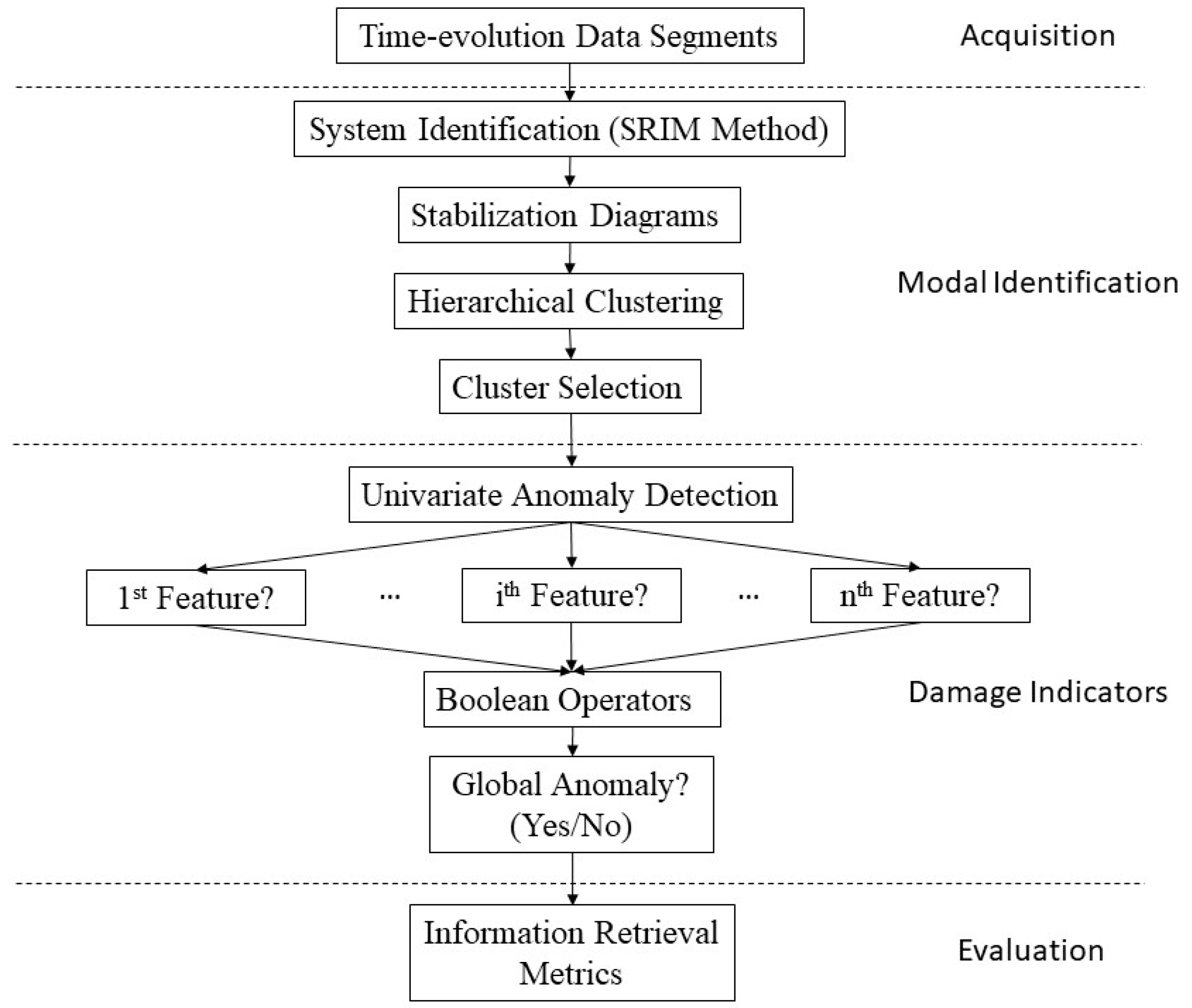


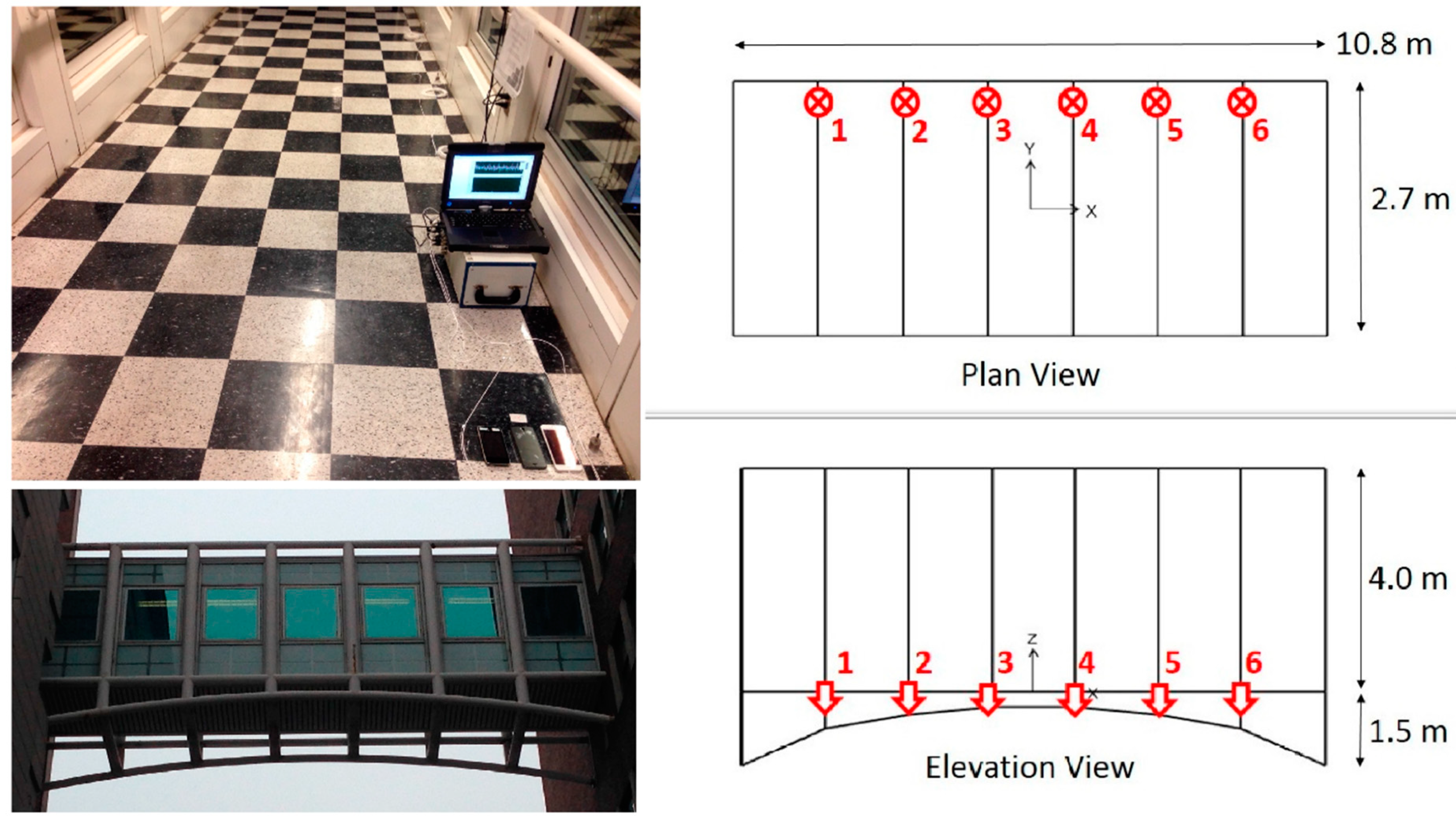
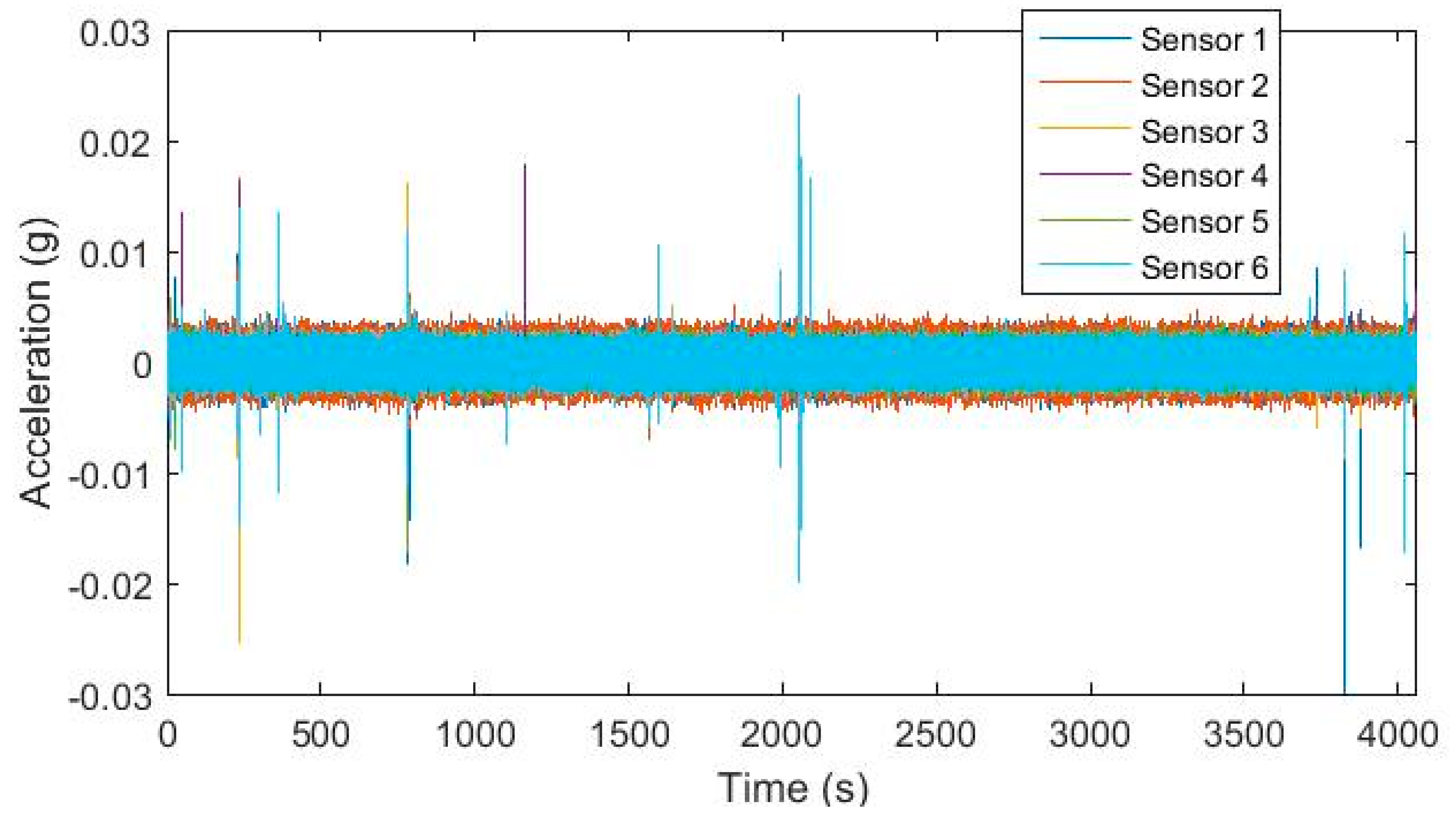
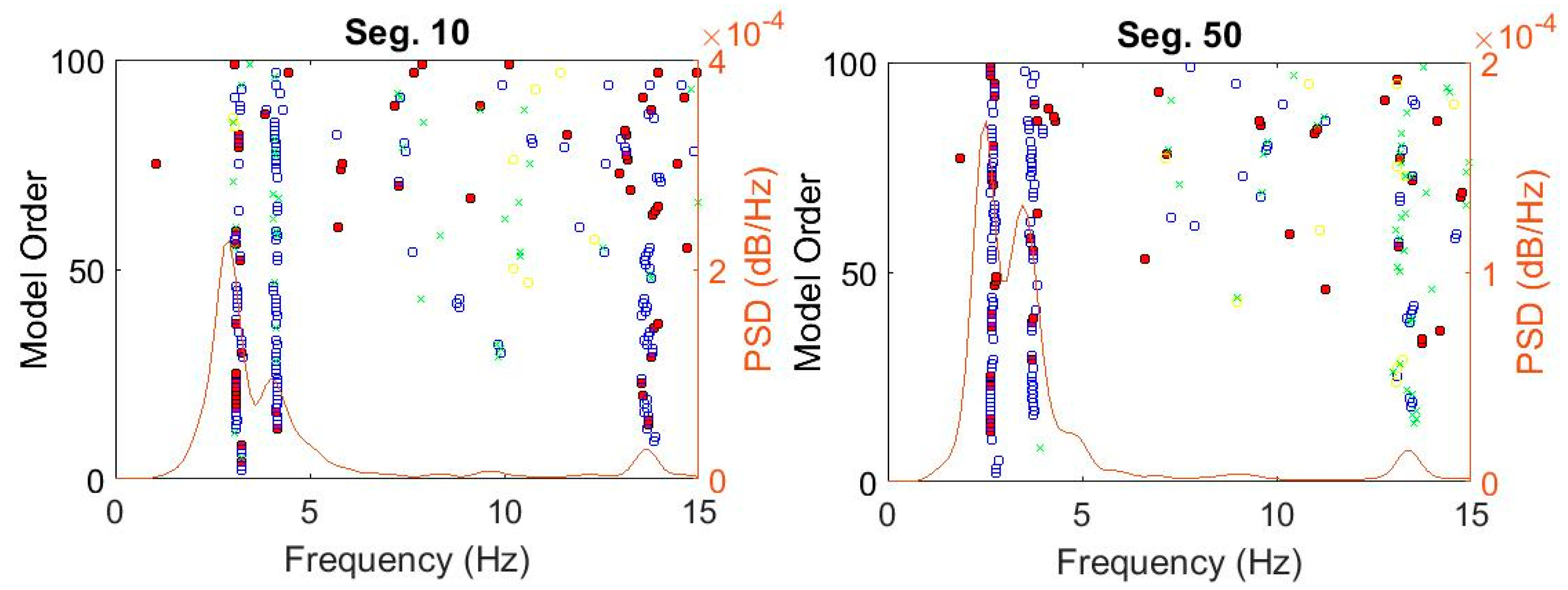
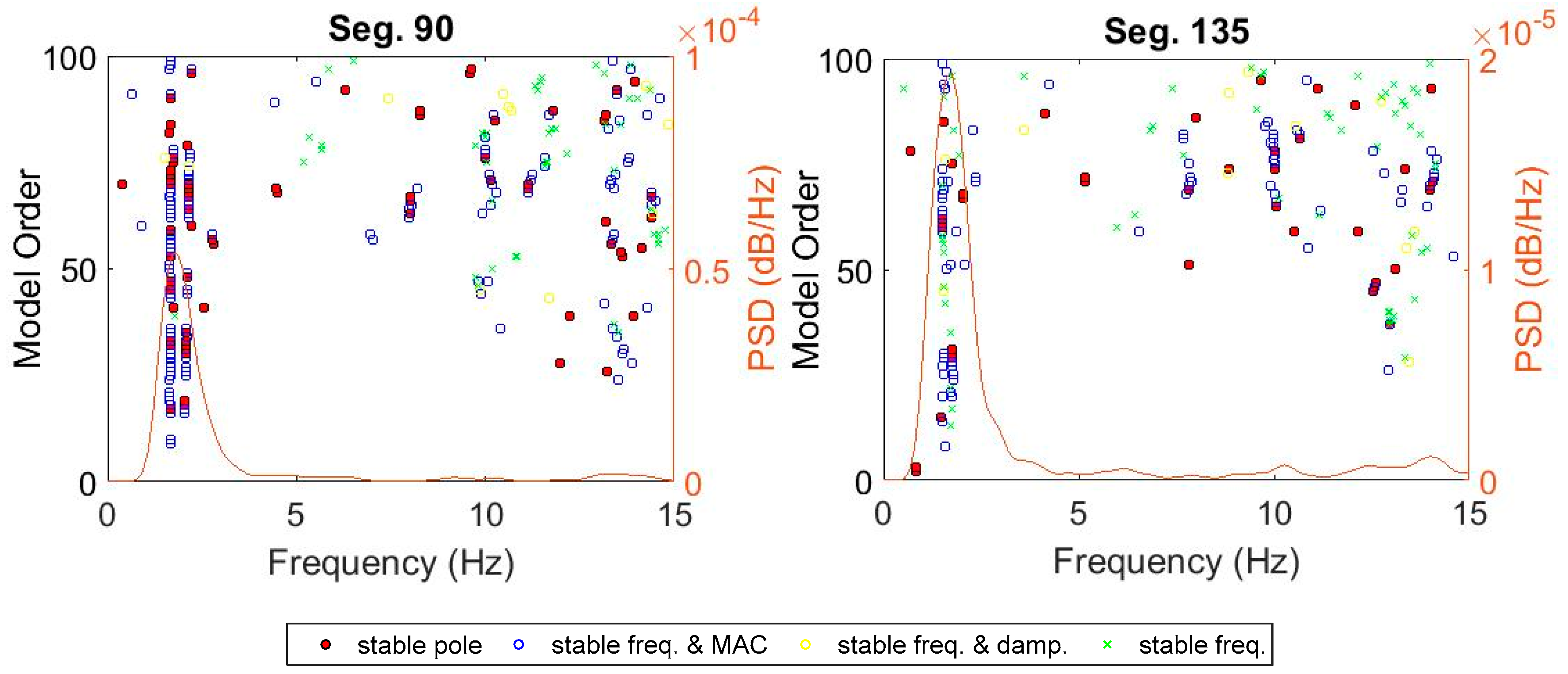
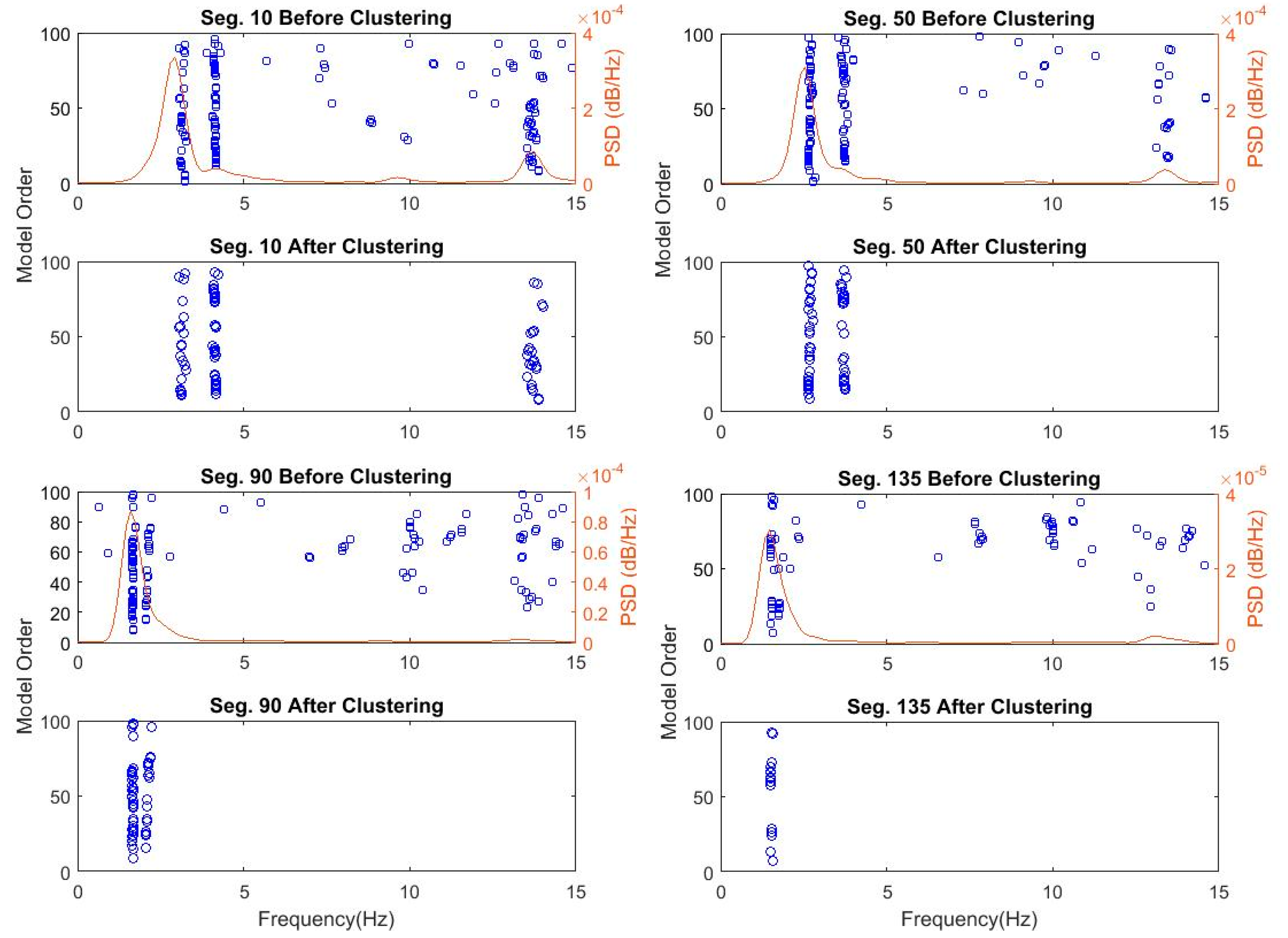
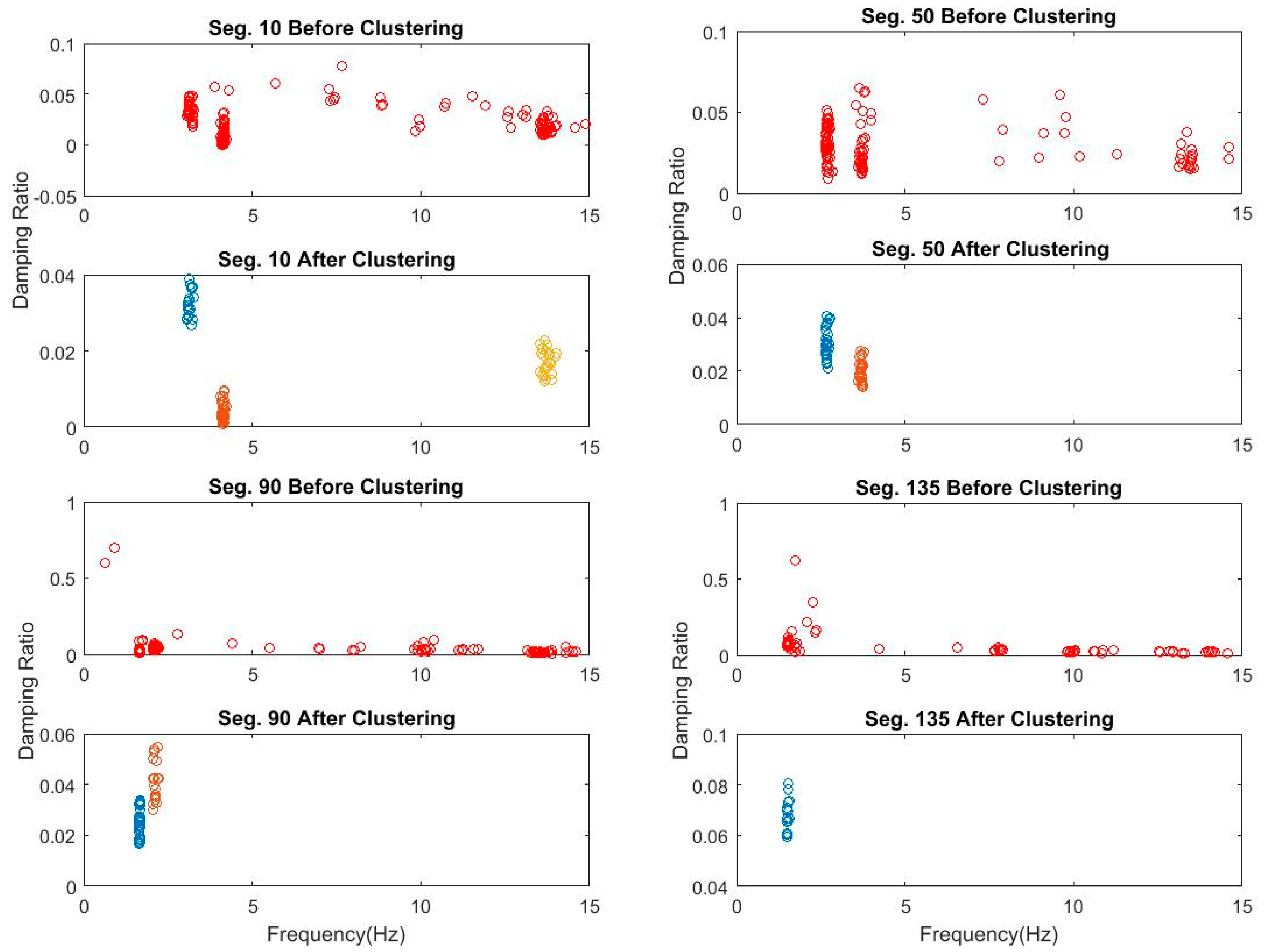

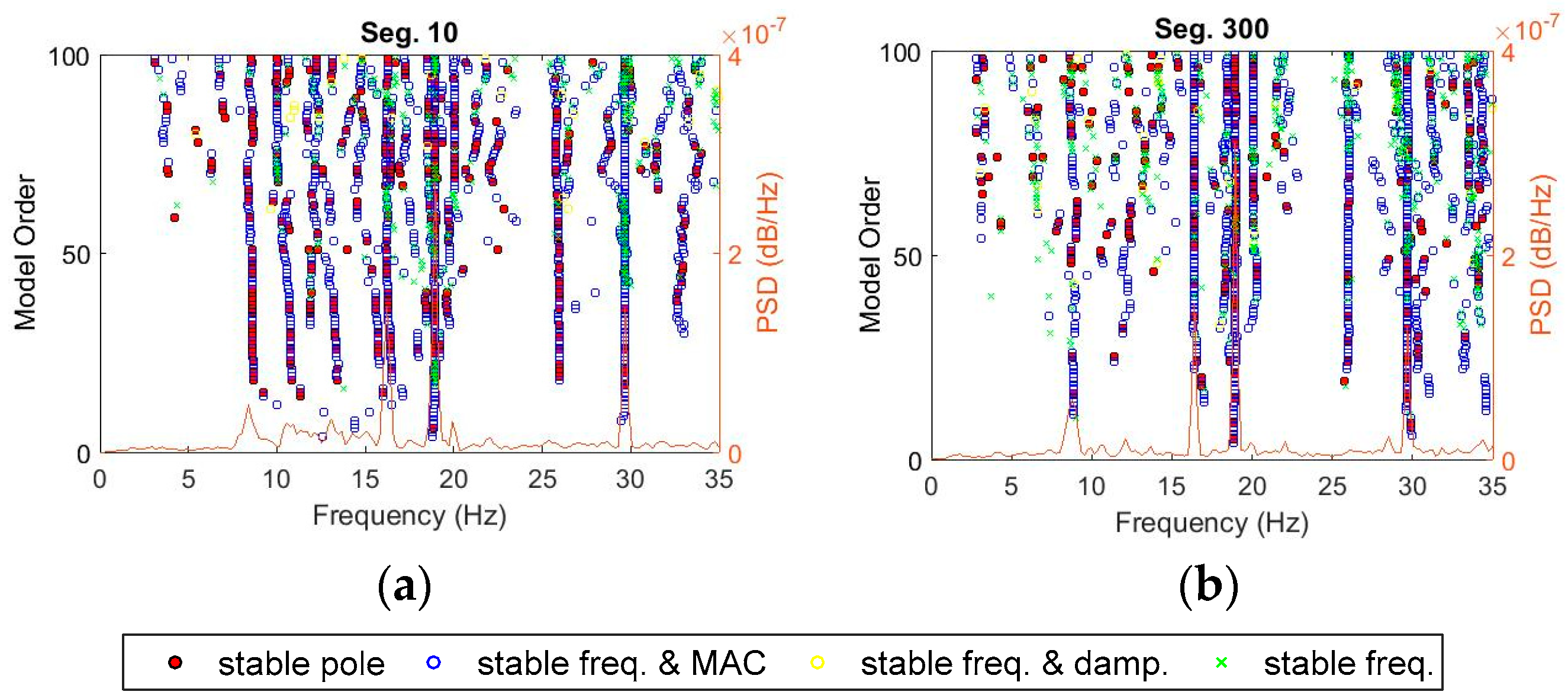
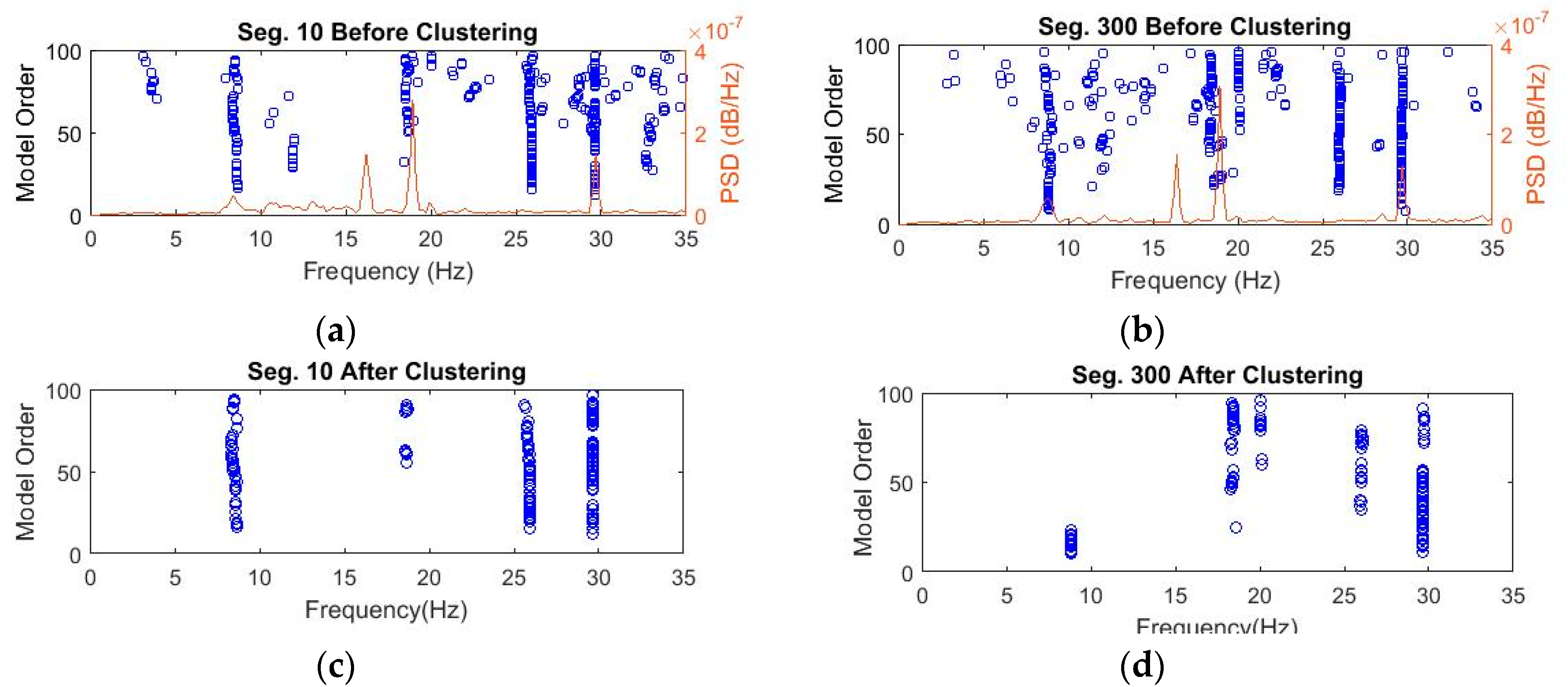

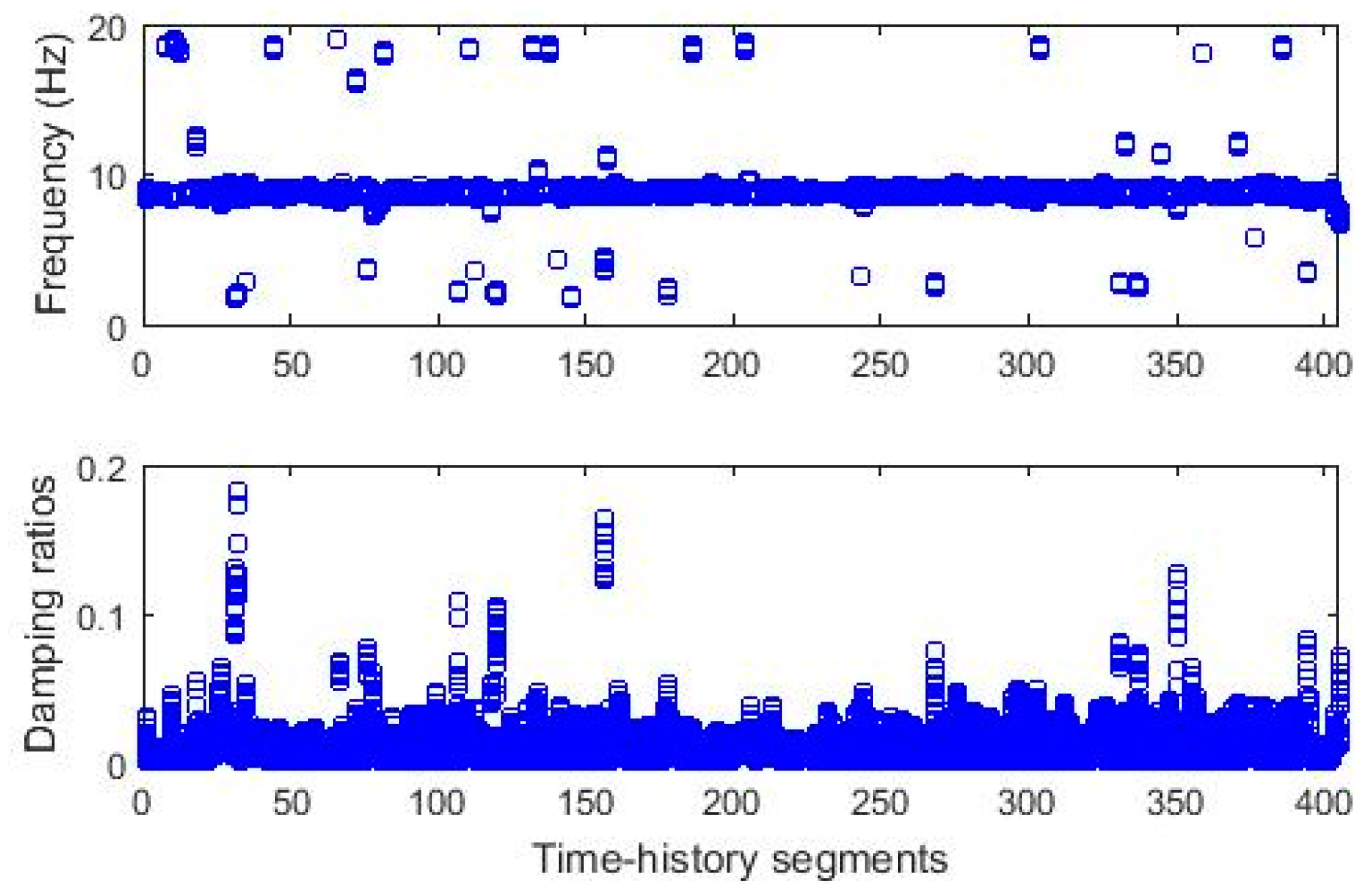

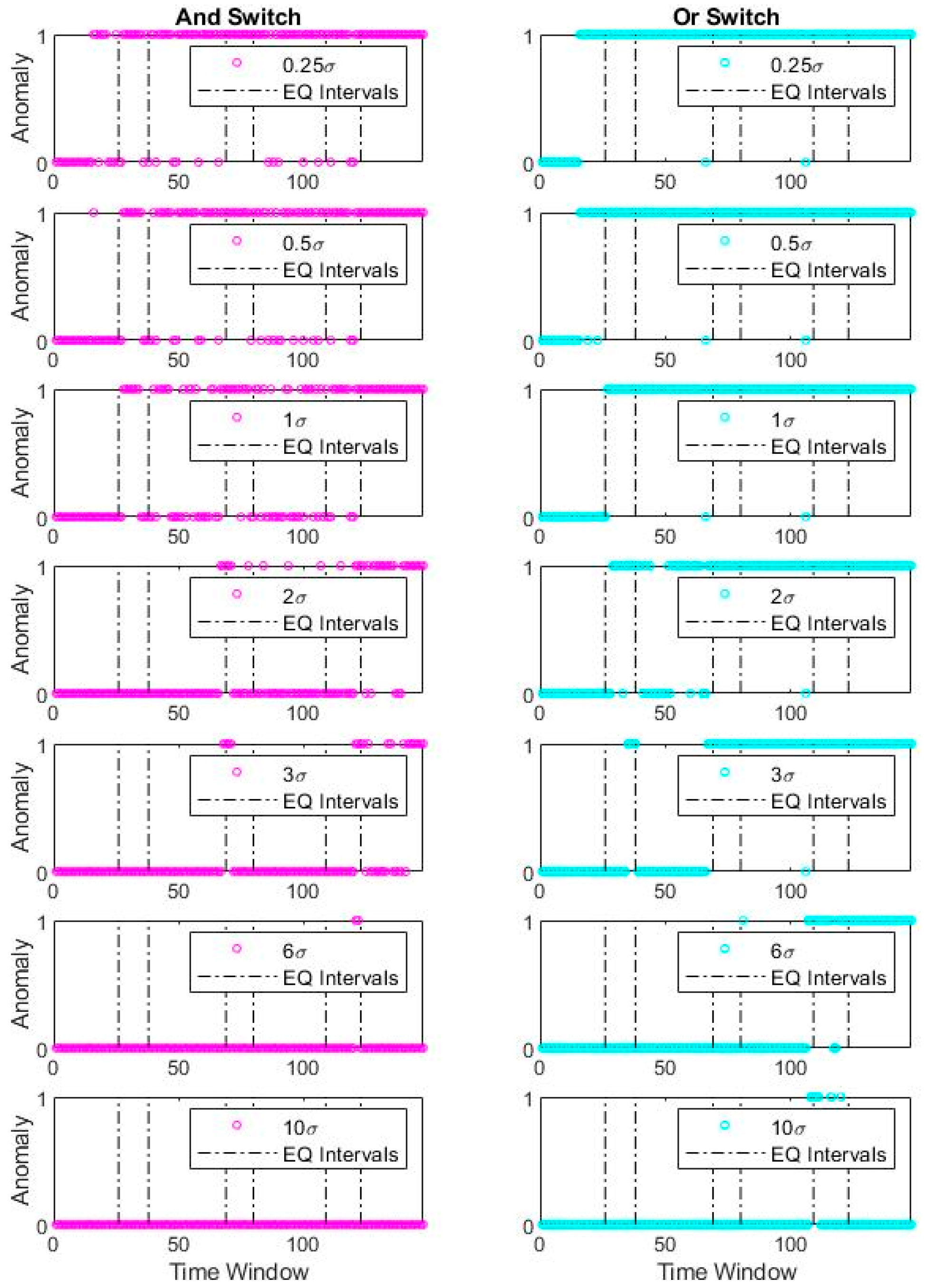
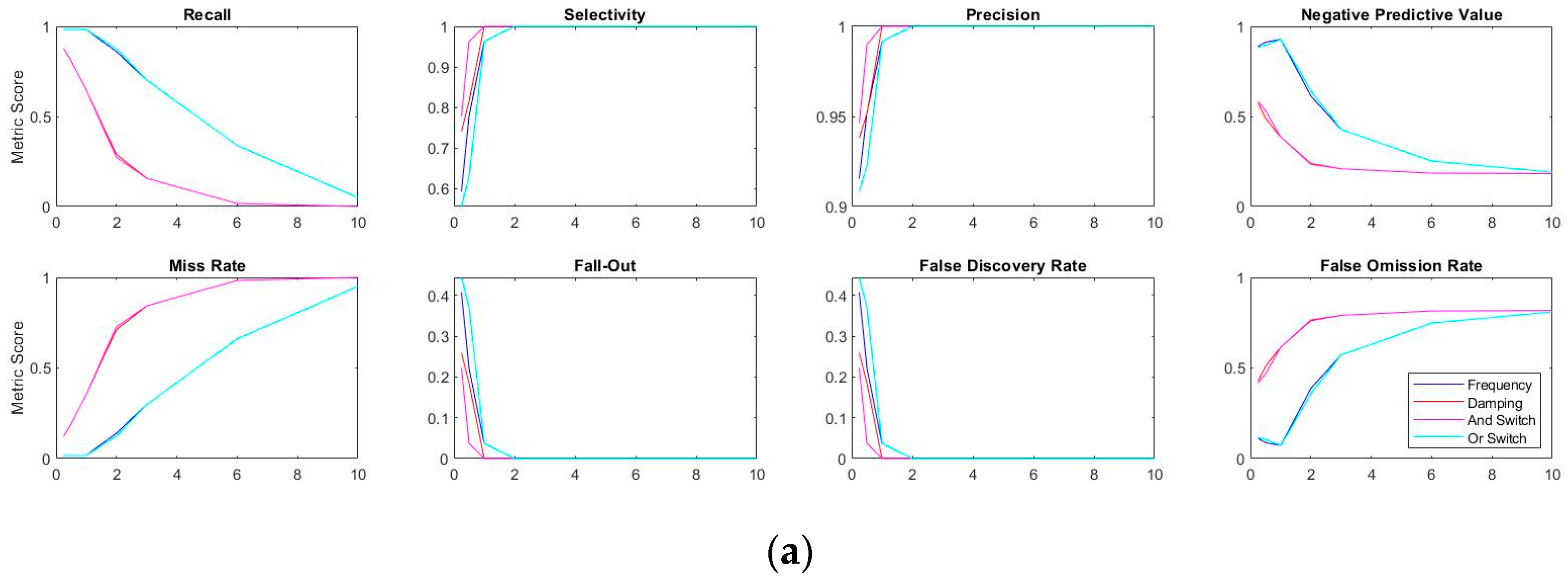
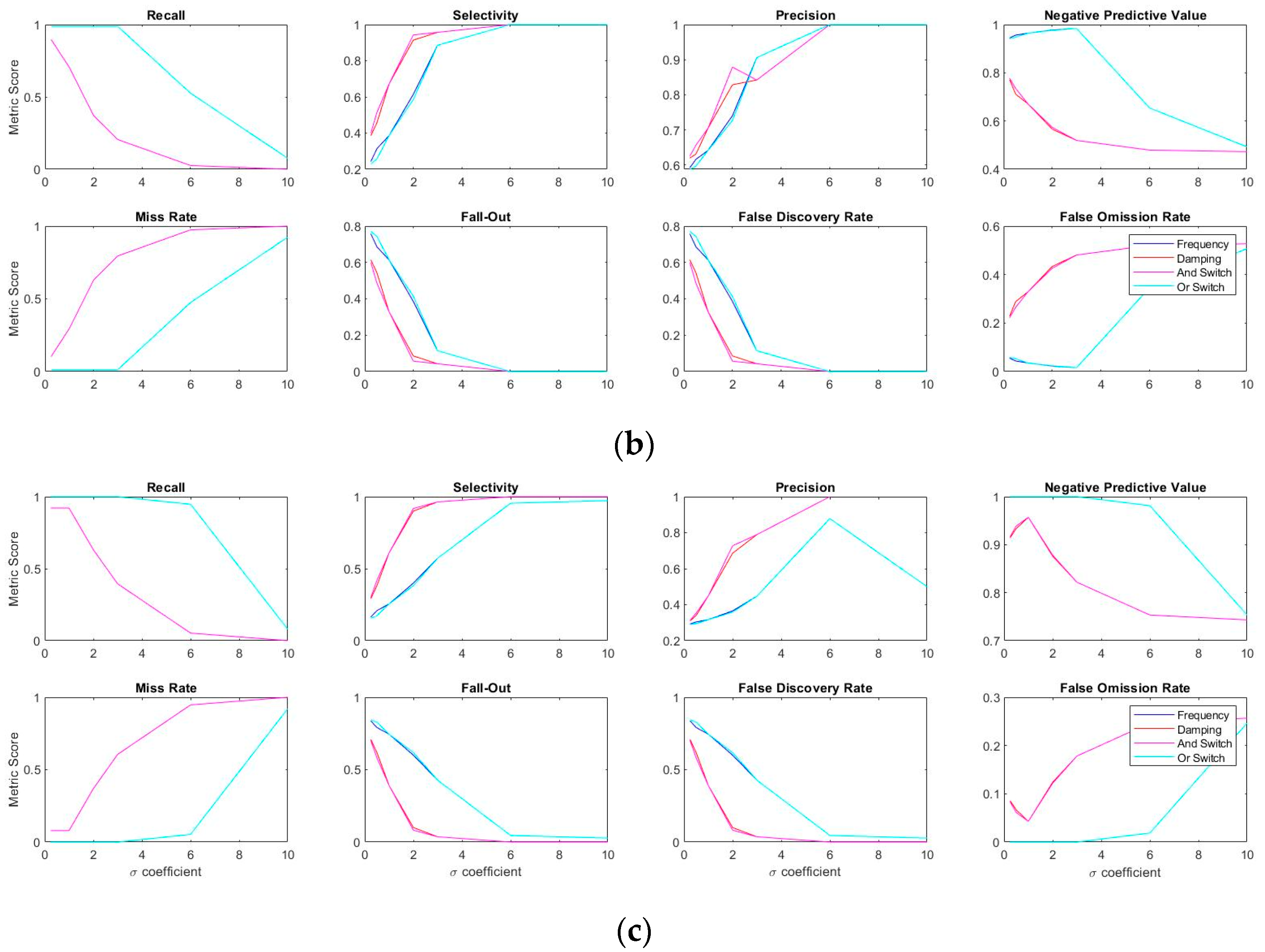

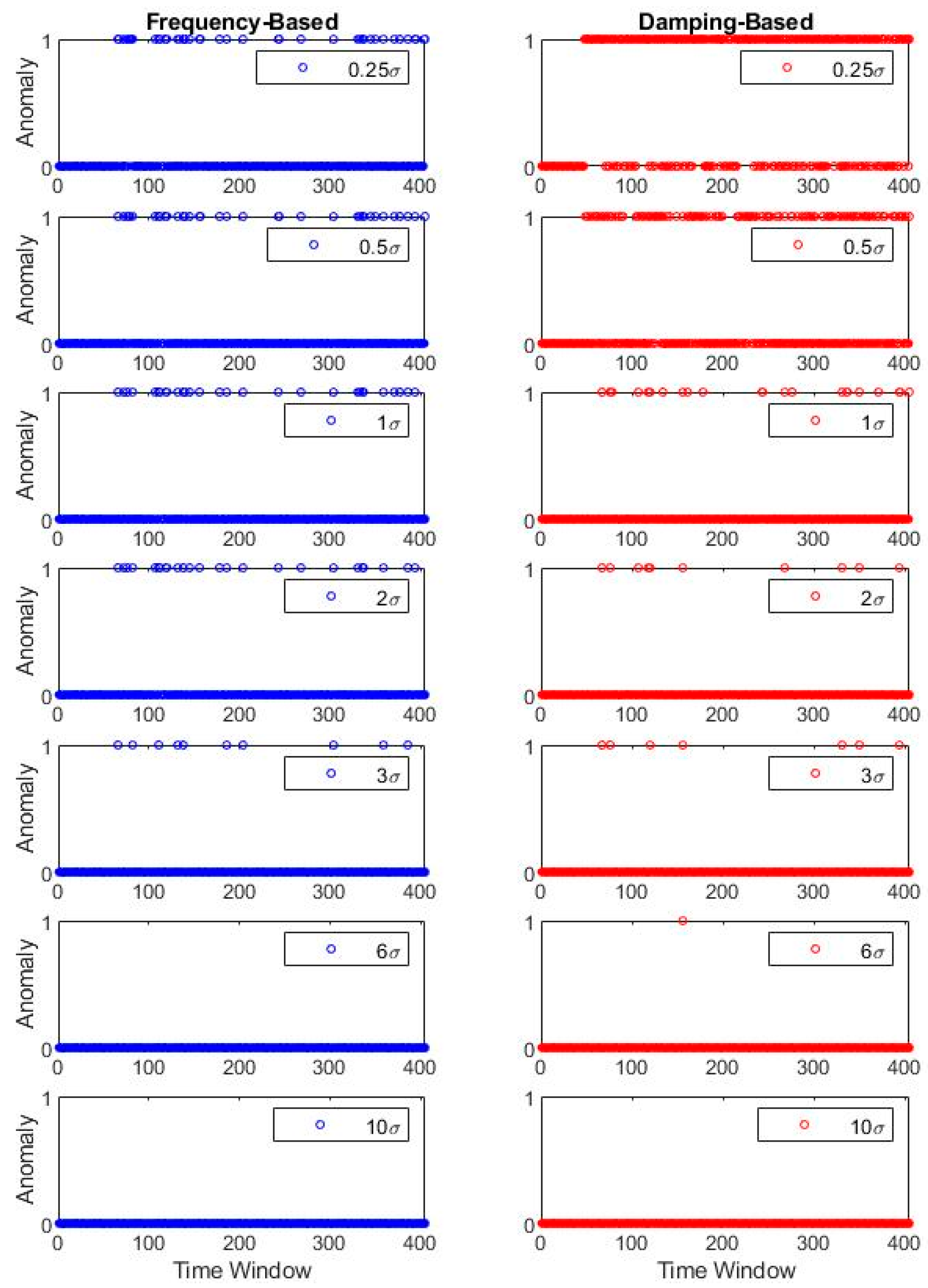
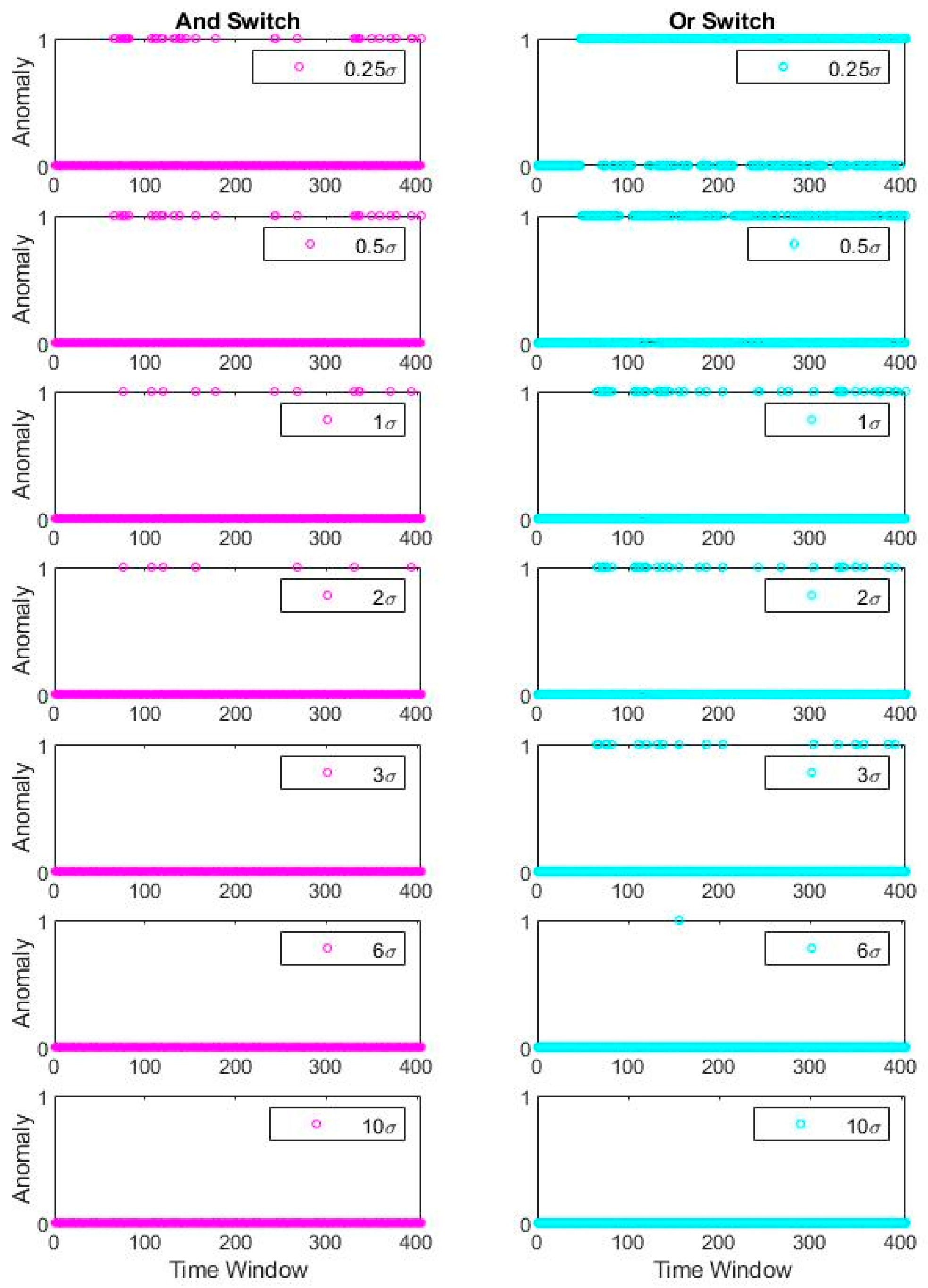

| Metric Expectation | Performance According to Detection Threshold σ | |||
|---|---|---|---|---|
| Decreasing | Increasing | |||
| Favored | Recall or true positive rate | Negative predictive value | Selectivity or true negative rate | Precision or positive predictive value |
| Unfavored | Fall-out or false positive rate | False discovery rate | Miss rate or false negative rate | False omission rate |
| Test ID | Description | Time Interval (s) | PGA (g) | Damage |
|---|---|---|---|---|
| WN1 | White noise | 0–70 | 0.07 | – |
| EQ1 | Moderate earthquake | 70–110 | 0.33 | Bent 1 and Bent 3 yield |
| WN2 | White noise | 110–170 | 0.07 | – |
| EQ2 | Severe earthquake | 170–210 | 1.15 | Bent 2 yields |
| WN3 | White noise | 210–260 | 0.07 | – |
| EQ3 | Extreme earthquake | 260–310 | 1.74 | Bent 3 buckles |
| WN4 | White noise | 310–379 | 0.07 | – |
© 2020 by the authors. Licensee MDPI, Basel, Switzerland. This article is an open access article distributed under the terms and conditions of the Creative Commons Attribution (CC BY) license (http://creativecommons.org/licenses/by/4.0/).
Share and Cite
Tran, T.T.X.; Ozer, E. Automated and Model-Free Bridge Damage Indicators with Simultaneous Multiparameter Modal Anomaly Detection. Sensors 2020, 20, 4752. https://doi.org/10.3390/s20174752
Tran TTX, Ozer E. Automated and Model-Free Bridge Damage Indicators with Simultaneous Multiparameter Modal Anomaly Detection. Sensors. 2020; 20(17):4752. https://doi.org/10.3390/s20174752
Chicago/Turabian StyleTran, Thanh T. X., and Ekin Ozer. 2020. "Automated and Model-Free Bridge Damage Indicators with Simultaneous Multiparameter Modal Anomaly Detection" Sensors 20, no. 17: 4752. https://doi.org/10.3390/s20174752
APA StyleTran, T. T. X., & Ozer, E. (2020). Automated and Model-Free Bridge Damage Indicators with Simultaneous Multiparameter Modal Anomaly Detection. Sensors, 20(17), 4752. https://doi.org/10.3390/s20174752






